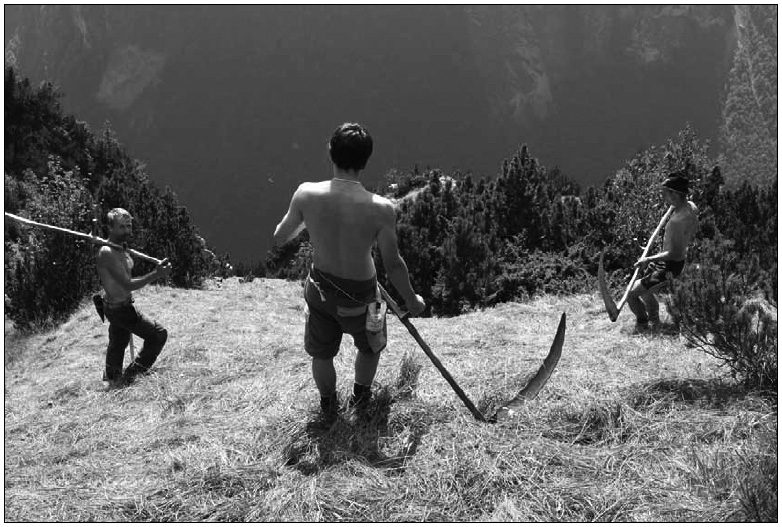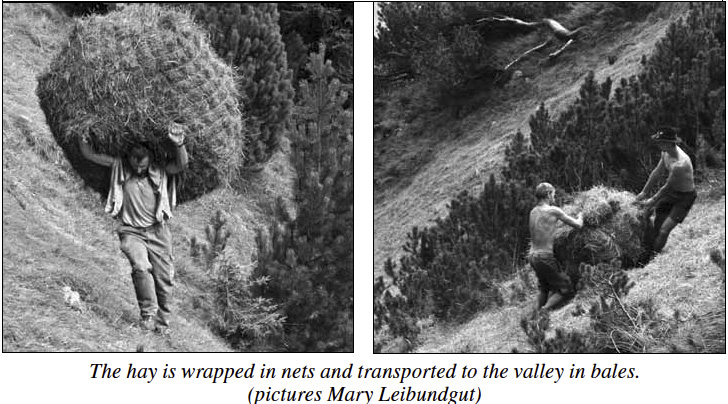Responsibility for the whole
Responsibility for the whole
“Isenthaler Wildheuer und Wildheulandschaft” (Isenthal wild haymaking and landscape of wild hay harvesting) awarded the Landscape of the Year 2016 by the ‘Swiss Foundation for Landscape Conservation (SL-FP)’
by Urs Knoblauch, cultural publicist, Fruthwilen TG
The species-rich dry grassland and wild hay are part of our impressive natural and cultural heritage. Anyone who has admired the splendour of alpine flowers, will also have given thought to the preservation and maintenance of these natural wonders. Switzerland is worldwide on top with its diverse wild hay grasslands and its care and therefore beares international responsibility. Here, the canton of Uri is particularly committed to responsibility. These species-rich Alpine grasslands are one of 39 endangered cultural landscapes of Switzerland.
The contribution of wild haymakers to nature, cultural property and to the common good

That the Swiss Foundation for Landscape Conservation (SL-FP) awarded this year’s prize the wild haymakers in the area of Lake Lucerne is very deserving. For centuries, the wild haymakers carry on this cultural tradition in the extremely dangerous mountain and Alpine landscapes. It requires quite a bit of force, trained skills and often quite some courage that the men – often with the help of women – can accomplish their work on the steep meadows and rock banks. This enables them to provide the necessary hardship hay for the cattle in the Alps or for year-round home operation or to bridge cold spells. The game benefits as well from the wild haymakers. Up here in the Alps every two to three years there is sporadic mowing, depending on the available working capacity, vigor and weather conditions. The transportation is in the beautiful looking Tristen (hayracks) which are stored directly in nature, or as heavy hay bales in nets. They are transported in simple rope constructions which are rich in ideas and over one hundred years old.
1,000 scythe-mown hectares
Hay making is part of an admirable and daring agricultural culture that includes a rich Alpine lifestyle of mutual aid. For generations interelligent techniques, practices and emotional experiences are passed on to the families and cooperatives. The oldest award winner of the Swiss Foundation for Landscape Conservation was 89, the youngest 16 years of age. “Astonishingly, in Switzerland more than 1,000 hectares are still mown with a scythe. Thereby valuable small structures such as anthills, stones and bushes survive; small animals such as lizwards, grasshoppers, or wild bees can also get to safety in time“. This can be read in one of the numerous information sheets of the foundation (and various nature conservation organizations) (Bafu, www.umwelt-schweiz.ch/publikationen). Thus, the wild haymakers contribute not only to food security but also to the important biodiversity of flowers and grasses as well as to stabilize the soil for avalanche control and to a valuable cultural asset. The more and more mechanical aids, hay blowers, bar movers and sometimes even helicopters are used today as necessary relief for the demanding and dangerous work. Adequate financial support is absolutely necessary especially for this kind of agriculture. It is modest, measured at the income opportunities in the lowlands. “Decisive, however, is the factor of the existing workforce, the inner attitude and the public appreciation of the wild haymaking”, writes Raimund Rodewald, current CEO at SL-FP.
Speaking to the wild haymakers and peasants it becomes clear how they are connected with faith in God with nature for their life tasks and feel responsible for the whole of human coexistence. With the traditional religious “Betrufen” (traditional prayer texts) that the Alpine people sing in the evening through a wooden funnel and thus also connecting with each other over the valleys with the gorgeous wayside crosses and chapels. They are asking for God’s help with the many existing dangers.

Impressive symposium, ceremony and award ceremony
The small mountain village of Isenthal is located in the canton of Uri at 778 metres above Lake Uri. Yet, the extremely steep ascent on foot, the trip by car or mail van through the picturesque rocky and forest landscape with imposing and dizzying views of the Lake Uri, is an imposant experience. In this pristine mountain nature of historic Switzerland the residents have come together to form a Confederation. This interaction is recorded in the Federal Charter of 1291. Independently, modest and in mutual help they mastered the constitution of the direct democracy and the common good. For long, there was no road to Isleten and Isenthal. The access was possible only by boat via Flüelen. Only in 1901, at the opening of the steamship station and with the help of vigorous Italian foreign workers the steep winding mountain road was built to Isenthal, through rocks and forest.
Up there the interesting and well-attended symposium of the Swiss Foundation for Landscape Conservation (SL-FP) was held on 12 August 2016, headed by Raimund Rodewald. At the beginning, a few days before fatally injured wild haymaker was commemorated. Numerous speakers from the municipality, the canton of Uri (Councillor Heidi Z’graggen), the federal government (Department of Agriculture) as well as professional organisations and representatives from South Tyrol acknowledged the hay making and gave valuable insights into the important cultural task of use and protection of the mountain landscapes. Historian Michael Blatter contributed with an excellent lecture on the history of wild haymaking. The field botanist Mary Leibundgut gave an impressive photo report on the work during hay making. It became clear how geographical and topographical characteristics are reflected in the cultural coexistence.
With a panel discussion, accompanied by an aperitif with local cheese, smoked mear and wine offered by the corporation Uri and a good conversation the meeting was ended. Saturday, there was the ceremony on the Alp Gitschen at 1,600 metres which is accessible by cable car. In beautiful summer weather, the award ceremony took place for the 30 wild haymakers. Again, the injured wild haymaking comrade was commemmorated with a short memorial mass. At Alphorn sounds, speeches and an original laudation by the wellknown filmmaker Fredi Murer who is enrooted in central Switzerland. Together with the winners the many visitors enjoyed the unique natural beauty of Alp Gitschen. The conversation with these wise and responsible-minded wild haymakers and their families was a special treat. In the afternoon, interested visitors had the opportunity to follow the preactical work on the ground and to lend a hand. The event was made possible by the canton, the community, the corporation, sponsors, and donors and was festively completed with a lunch. A lasting and shared experience of lived responsibility for the whole. •
(Translation Current Concerns)
Swiss Foundation for Landscape Conservation honours cultural landscapes
uk. Every year since 2011 the Swiss Foundation for Landscape Conservation (SL-FP) honours a special cultural landscape of Switzerland. The Foundation was founded in 1970 with the purpose of “preservation, maintenance and enhancement of landscapes worth protecting“. DDr h. c. Raimund Rodewald is the current managing director and publishes repeatedly excellent publications on the subject. (In Current Concerns No 29, 2012, he has reported on the terraced landscapes.)
The Foundation was already able to realize numerous valuable projects and thus to draw the attention of the public onto the nature and landscape protection and their diversity. “Its aim is to safeguard the natural and cultural values of the landscape, promote it and, restore it where necessary. For this it advocates in particular through advice, expertise, training, project work, publications and other appropriate ways.” This concern is particularly valuable especially in the context of major structural changes and construction. The Foundation is a private non-profit organisation and works closely together with the authorities and organisations that deal with spatial planning, nature protection, townscape and monument protection, tourism and others. Its concern and that of many other organisations is necessary and is broadly supported.
In 2013, the popular vote on the revision of the Swiss Spatial Planning Act expressed the joint responsibility of the Swiss people; the popular vote was adopted with almost 63%. Still, in the Annual Report 2015 of the SL-FP Kurt Fluri, National Councillor and President of the Board of the SL-FP, has pointed out: “The loss of cultivated land is unrestrained and the loss rate due to the current construction boom is probably still higher than in the years between 1979/85 and 2004/09. Within 24 years, [...] approximately 54,000 hectares of arable land have been converted to urban areas.” End of 2015, again, 30,000 hectares were added by further “exploitation tasks, a total of 84,000 hectares of arable land, which matches the area of the Canton of Jura“. In addition, more and more people live in big cities and the direct relationship to nature and agriculture gets lost. Fluri points out that the main reason for the loss of cultivated land is the spread of urban areas, mainly by home and road construction.